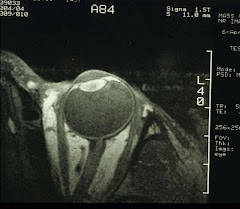Sun/UV damage to the eye comes in many flavors. The one we still occasionally see is solar retinitis, i.e., staring at the sun with unprotected eyes for a prolonged period of time. The reason for this behavior is unknown, it certainly is a good way of burning up your fovea quickly, resulting a small central scotoma. Sometimes there is recovery from re-grouping of the cones. Most often, not.
Then there is "sunburn" of the cornea, i.e., solar/UV keratitis. The source of the UV is not necessarily the sun, it can be a sunlamp or welding arcs. Needless to say, it is quite uncomfortable.
The most prevalent UV-related damage is actually pterygium.
Pterygium is a benign fibroblast growth from the conjunctiva into the cornea (the more localized form is called pinguecula). The image below shows a mild case. Occasionally it becomes inflamed. In more serious cases, the growth can extend into the pupillary area obstructing vision. Then a surgical excision and corneal transplant maybe needed.
 In a recent study by the ophthalmology researchers at Kanazawa Medical University in Japan, pterygium appears to occur at a far higher incidence among the residents of the Island of Hainan in Southern China than the residents in Northeast China. Higher UV and ambient temperature appear the two most prominent factors.
In a recent study by the ophthalmology researchers at Kanazawa Medical University in Japan, pterygium appears to occur at a far higher incidence among the residents of the Island of Hainan in Southern China than the residents in Northeast China. Higher UV and ambient temperature appear the two most prominent factors.All of a sudden, it is a public health issue because the more extensive form of pterygium affects people, especially farmers, in all tropical areas. There are many unresolved issues: how to treat and rehab existing cases, how to prevent the occurrence of pterygium and in what way, even how to persuade the somewhat skeptical farmers to wear UV-blocking gears including eyewear.











No comments:
Post a Comment